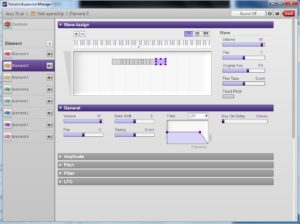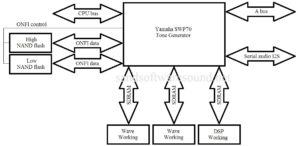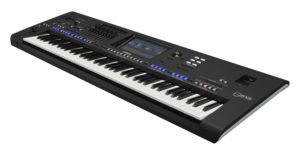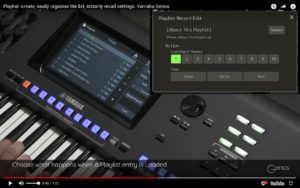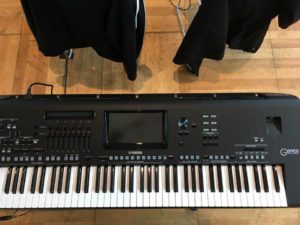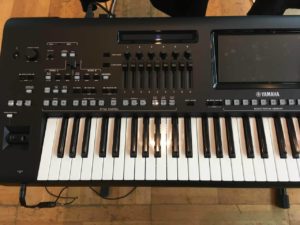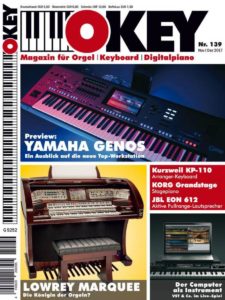The Yamaha Genos™ Reference Manual and Data List PDF files are now available. Please see your local Yamaha support site.
When I check out a new keyboard, I ask, “What’s truly new and what’s recycled?” The Genos breaks new territory and draws heavily on new Montage waveforms, as well as recycling the good stuff from Tyros 5. Now that the waveform memory barrier is broken, Genos includes all of the Tyros 5 legacy stuff, adopts many waveforms from Montage, and gives many voices a major boost to Super Articulation 2 (SArt2).
Many of the T5 voices are renamed in Genos. One needs to compare the MSB, LSB and program change numbers across models. Renaming drives me crazy! The Telecaster guitar voices now begin with the prefix “50s,” and presumably, the new Stratocaster guitar begins with the prefix “60s.” I guess the Gibson SG is next to be sampled. 🙂
I have to warn you that my analysis reflects my own musical interests and needs: mainly liturgical music and funk. If you’re looking for pads, synths, etc., there aren’t the droids you’re looking for.
First, the major stuff recycled from Tyros 5:
- Seattle strings (now explicitly identified as such)
- Electric piano “body” waveforms.
- Flamenco guitar
- Telecaster guitar (now renamed “50s”)
- Celtic violin
- Orchestra horns, trumpets and trombones (sections)
- Classical flute and clarinet
Please don’t consider “recycled” as a negative criticism. These instruments are all quite good.
Now the stuff from Montage:
- CFX acoustic grand
- CP80 electric grand
- Electric piano ambient noises
- Scottish accordeon
- Steel acoustic guitar (Gibson)
- D folk guitar (Martin D45)
- Bass trombone
- Oboe and bassoon
Voices that did not make the jump to hyperspace are: euphonium, piccolo trumpet, contra bassoon, Celtic harp. I’m still trying to sort out solo French horn. If these voices are critical to you, I guess you’re buying a Montage.
The Wurlitzer electric piano might have gotten a touch up. I won’t know until I play the Genos. The Montage Wurli included ambient noises. For some reason, The Yamaha euphemism for “Wurlitzer” is “70sVintage”. Arg, I hate this naming nonsense.
Let’s move on the totally new stuff:
- C7 acoustic grand
- Kino strings (sections, spicatto, tremolo)
- Stratocaster guitar (prefix “60s”)
- Resonator guitar
- Ukelele
- Mandolin
- Pedal steel guitar
- Active bass fingered and picked (Stringray bass)
There are other new voices like accordions and such.
Woodwinds, in general, appear to have gotten a major update. Many of the voices are now SArt2. I’m very happy to see SArt2 oboes since I use oboe (and flute) in many exposed lines. I’m also glad to see SArt2 funk alto sax and baritone sax.
If you are a songwriter or composer and need strings, look no further. You have choice between two very able and tricked out string “packages:” Seattle and Kino. The Seattle strings first appeared in Tyros 5 and then were heavily promoted during the Montage launch. Kino strings are an all new addition. Genos offers solo cello voices, too. Yeah!
That’s my preliminary analysis. Genos is checking off a lot of my boxes and criteria for a new ax. More to come as I dig deeper.
Copyright © 2017 Paul J. Drongowski
Motif XF Montage Genos
---------------- ---------------- ----------------
CF3 CFX CFX
S6 S700
C7
EP 1-3 EP 4
Rd 70sSuitcase
Rd73
Rd78
Rd Noise 70sSuitcase
Wurli EP Wr 1-3 70sVintageEP
Wr Noise
Clav 1-4 Clav 5 Clavi/ClaviFunk T5
Clav Noise
Upright UprightPiano
CP70 CP80 CP80 ElectricGrand
CP80 KeyOff
Vibraphone 1-2 Vibraphone 3 Vibraphone T5
Motor Vibes
Pipe Organ 1-5
Tone Wheel 1-6
SctAcc Musette ScottishAccordeon
Nylon 1 Nylon 2
Flamenco FlamencoGuitar T5
Steel 2-3 SteelAcoustic, D-FolkGuitar
Telecaster (TC) 50sVintageStage T5
Acoustic Bass 1 Acoustic Bass 2
Violin 1 Violin 2 1st Orchestral 1stVln T5
Violin 2 2nd Orchestral 2ndVln T5
Viola 1 Viola 2 OchestralViola T5
Cello 1 Cello 2 OrchestralCello T5
Contrabass 1
US Strings SeattleStrings T5
Violins 1st Seattle1stViolins T5
Violins 2nd Seattle2ndViolins T5
Violas SeatleViolas T5
Cellos SeattleCellos T5
ContBasses SeattleBasses T5
CelticHarp
Celtic Violin CelticViolin SArt2 T5
Trumpet 1-2 Trumpet 3 ClassicTrumpet SArt2 T5
Piccolo Tp
Trumpet Mute MuteTrumpet SArt2 T5
Soft Trumpet SoftTrumpet SArt2
Trombone 1-2 Trombone 3 ClassicTrombone T5
Bass Trombone BassTromTenuto
Euphonium
French Horn 1 French Horn 2
French Horns 1 French Horns 2-3 OrchHorns T5
Trumpets 1-2 OrchTrumpets T5
Trombones 1-2 OrchTrombones T5
Soprano Sax 1-3 BalladSopranoSax T5
Alto Sax 1-3 AltoSax SArt2
Tenor Sax 1-2 TenorSax SArt2
Clarinet 1 Clarinet 2-3 Clarinet SArt2
Oboe 1-2 Oboe 3-4 Oboe SArt2
Bassoon 1 Bassoon 2-3 Bassoon SArt2
Flute 1-2 Flute 3-4 ClassicalFlute SArt2 T5
CBassoon 1-2
Piccolo 1-2 Piccolo 3-4
Note :T5" means "Added in T5 and included in Genos"

